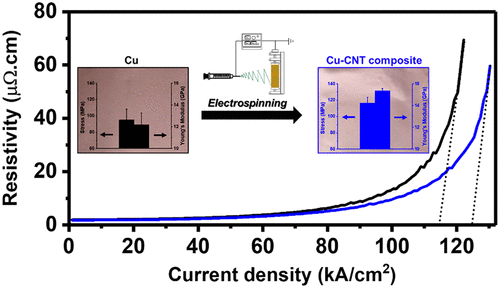当前位置:
X-MOL 学术
›
ACS Appl. Nano Mater.
›
论文详情
Our official English website, www.x-mol.net, welcomes your feedback! (Note: you will need to create a separate account there.)
Copper–Carbon Nanotube Composites Enabled by Electrospinning for Advanced Conductors
ACS Applied Nano Materials ( IF 5.9 ) Pub Date : 2020-06-18 , DOI: 10.1021/acsanm.0c01236 Kai Li 1 , Michael McGuire 2 , Andrew Lupini 3 , Lydia Skolrood 1 , Fred List 2 , Burak Ozpineci 4 , Soydan Ozcan 5, 6 , Tolga Aytug 1, 7
ACS Applied Nano Materials ( IF 5.9 ) Pub Date : 2020-06-18 , DOI: 10.1021/acsanm.0c01236 Kai Li 1 , Michael McGuire 2 , Andrew Lupini 3 , Lydia Skolrood 1 , Fred List 2 , Burak Ozpineci 4 , Soydan Ozcan 5, 6 , Tolga Aytug 1, 7
Affiliation

|
The power losses associated with the electrical resistance of copper (Cu) have generated considerable interest in the development of advanced conductors that incorporate carbon nanotubes (CNTs) into the Cu matrix—ultraconductive Cu (UCC) composites—to increase energy efficiency in various industrial and residential applications, ranging from electric power transmission and rotating machinery to electronic devices. To meet this demand, we describe an electrospinning-based polymer nanofiber templating strategy for the fabrication of UCC composites with electrical and mechanical performance exceeding that of Cu. Our approach involves electrospinning of polyvinylpyrrolidone (PVP)-based solutions containing CNTs into aligned PVP/CNT nanofibers onto Cu foil substrates, followed by vacuum-assisted thermal removal of organic solvent/polymer from the CNT matrix to achieve a uniformly distributed CNT layer on the Cu surface. Following additional Cu deposition, the Cu–CNT–Cu composites demonstrated similar electrical conductivity, higher current carrying capacity, and improved mechanical properties compared with those obtained from reference Cu. Importantly, after the heat treatment, Raman analysis of the CNT network displayed an increased metallic character that supports the enhanced electrical properties of the UCC composites. Thus, we believe that these performance characteristics together with the commercial viability of the present approach could open new possibilities in designing advanced conductors for a broad range of electrical systems and industrial applications.
中文翻译:

通过静电纺丝实现高级导体导体的铜碳纳米管复合材料
与铜(Cu)电阻相关的功率损耗引起了人们对开发将碳纳米管(CNT)掺入Cu基体(超导Cu(UCC)复合材料)以提高各种工业和工业领域的能源效率的先进导体的兴趣。从电力传输和旋转机械到电子设备的住宅应用。为了满足这一需求,我们描述了一种基于静电纺丝的聚合物纳米纤维模板化策略,用于制造电气和机械性能超过铜的UCC复合材料。我们的方法涉及将包含CNT的基于聚乙烯吡咯烷酮(PVP)的溶液电纺成对齐的PVP / CNT纳米纤维到Cu箔基板上,然后真空辅助从CNT基体中热去除有机溶剂/聚合物,以在CNT表面获得均匀分布的CNT层。与参考铜相比,在额外的铜沉积之后,铜–碳纳米管–铜复合材料表现出相似的电导率,更高的载流能力和改善的机械性能。重要的是,在热处理之后,对CNT网络的拉曼分析显示出增加的金属特性,这支持了UCC复合材料增强的电性能。因此,我们相信这些性能特征以及本方法的商业可行性可以为设计用于广泛电气系统和工业应用的高级导体开辟新的可能性。
更新日期:2020-07-24
中文翻译:

通过静电纺丝实现高级导体导体的铜碳纳米管复合材料
与铜(Cu)电阻相关的功率损耗引起了人们对开发将碳纳米管(CNT)掺入Cu基体(超导Cu(UCC)复合材料)以提高各种工业和工业领域的能源效率的先进导体的兴趣。从电力传输和旋转机械到电子设备的住宅应用。为了满足这一需求,我们描述了一种基于静电纺丝的聚合物纳米纤维模板化策略,用于制造电气和机械性能超过铜的UCC复合材料。我们的方法涉及将包含CNT的基于聚乙烯吡咯烷酮(PVP)的溶液电纺成对齐的PVP / CNT纳米纤维到Cu箔基板上,然后真空辅助从CNT基体中热去除有机溶剂/聚合物,以在CNT表面获得均匀分布的CNT层。与参考铜相比,在额外的铜沉积之后,铜–碳纳米管–铜复合材料表现出相似的电导率,更高的载流能力和改善的机械性能。重要的是,在热处理之后,对CNT网络的拉曼分析显示出增加的金属特性,这支持了UCC复合材料增强的电性能。因此,我们相信这些性能特征以及本方法的商业可行性可以为设计用于广泛电气系统和工业应用的高级导体开辟新的可能性。


























 京公网安备 11010802027423号
京公网安备 11010802027423号